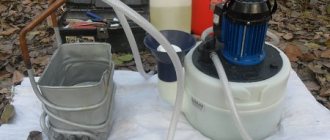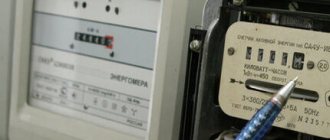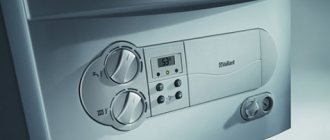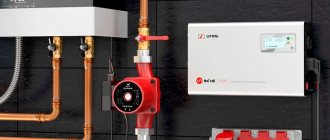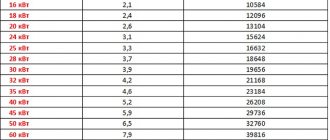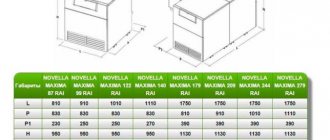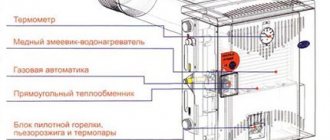UPS is a device that provides secondary power to devices when the main source is turned off. It also protects devices connected to it from interference such as:
sudden increase, decrease, loss of voltage;- voltage surges;
- frequency fluctuations;
- high-voltage pulse interference.
Main components:
- Converter. Converts and stabilizes current.
- Switch. Timely switches the device connected to the UPS from the main power supply to the backup one, preventing the latter from turning off or rebooting.
- A battery or other device that stores electricity.
Making a UPS for a boiler with your own hands
A UPS or UPS installation is a device that helps protect the boiler connected to it from power surges. It is also used if there is a short-term power outage and there is a problem with high-frequency noise. The UPS has a powerful battery to maintain backup power for a short period of time. It works for a long time and often depends on the battery in it. The better the battery, the longer its service life.
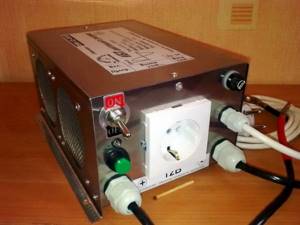
You can make a UPS for a boiler using a diagram, skills in working with construction tools and advice from experienced craftsmen. Manufacturing will cost from 10 to 12 thousand rubles. A ready-made device in a store will cost about twice as much. This may be one of the reasons to create the device yourself.
How to make a UPS with your own hands
The most important thing is to choose the optimal pulse unit and inverters; we recommend buying a model with a high level of efficiency, from 28 V. This will allow you to connect devices directly to the UPS, without adapters. The high level of transmitted charges maintains the boiler’s operation at the desired level, protecting it even from strong voltage surges. Below is a diagram of the device’s operation and connection principles; please note that you need to connect the adapters quite close to each other, this way we minimize energy dissipation.
The connection is made so that energy does not pass to the boiler when the adapter is turned off or if the power supply system is not working correctly. The fan cannot be powered from the output terminals; it is a very fragile part, the failure of which can affect the operation of the entire structure. If you need to cool a powerful stabilizer, we recommend using a radiator.
The inverter also needs to be purchased separately; we recommend choosing a model with a modified sine wave.
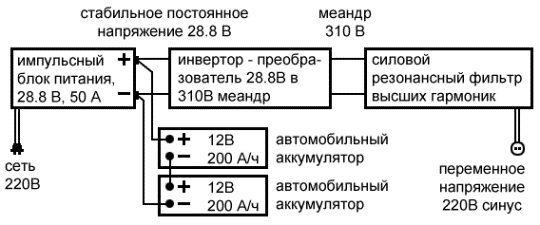
Uninterruptible power supply circuit
It will also be necessary to use wires up to 12 square mm in cross-section made of copper (they allow up to several tens of watts to pass through). When connecting to batteries, the wires must be tinned to prevent the appearance of an oxide film. Periodic surface treatment with special compounds is also suitable.
If necessary, devices can be equipped with a timed shutdown function by connecting a temporary relay to the board.
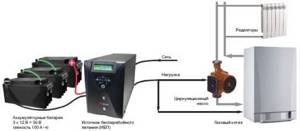
UPS for gas boiler
Before connecting a homemade UPS. You need to check the correct connections using a multimeter. The main disadvantage of a prefabricated household uninterruptible power supply for a boiler is low performance, large dimensions (weight reaches several dozen), short duration of continuous operation - up to 30 hours.
What you need
Creating an uninterrupted installation for a boiler or for a circulating pump for heating with your own hands requires the creation of an inverter device, from which a direct current in the battery is obtained in the amount of 220 volts. Naturally, it is better to create a UPS from a battery due to its low cost. For the normal functioning of a boiler running on electricity, it is better to install an inverter device of the CPS type (the optimal indicators are 3500, 7500 and 5000 PRO).

Nuances and possible errors
To prevent cooling of the coolant, you need to create a harmonious system for voltage filters. It can be created using a proven schema. These types of filters include various resistors, transformers and other auxiliary devices.
A properly designed system will be able to organize stable operation of any source of electricity. Its scheme is simple, any novice master can handle it.
The first priority is to calculate the parameters. The components of the contour are calculated and made in an identical way. It is collected in a sequential or parallel manner. In either case, a frequency of fifty gigahertz is created. Next, calculate the parameters of the inductive coils under the core. A gap is made in the core between the turns.
Universal formulas for calculating all the necessary components look like this:

To eliminate possible errors in creating uninterruptible heating, you need to take care of safety.
- Gloves should be worn to avoid electric shock from wires or contact with them.
- You need to carefully inspect the wires. There should not be any cracks in them, since a short circuit is very dangerous for the health of the master and the premises (it can lead to a fire).
- The system requires the connection of several batteries (it is better to take several fully charged ones and connect them in parallel. In order to save money, you cannot take cheaper devices, since their quality and operating time usually cost accordingly. There is no need to connect everything unnecessary to the device. It should be used specifically for devices of equal power. However, for computer devices, as usual, this power is quite enough. The main thing is not to exceed the total power. The best choice is phase-dependent models.
UPS for a boiler yourself: step-by-step instructions
Self-assembly of an uninterruptible power supply is real. It will require specific skills. If a person does not have knowledge in this area, it is better not to create an uninterruptible system with his own hands. A person will lose time, energy and money in vain. In addition, it is worth paying attention that a self-designed system will not look aesthetically pleasing. It will not work with many of the functions found in store-bought models. In addition, it will not be automated. It will need to be controlled manually.
To create a power supply, you need to take:
- Inverter 12 to 220 V. Inverter devices differ from each other in power and signal output shape. For a specific case, you will need a device with characteristics of 600 W (maximum) and 300 W (minimum).
- Battery. The better the battery, the longer the UPS can work autonomously. A 45A device will operate for eight hours. Accordingly, the higher the battery charge, the longer its operating life per day. Gel batteries work best because they last longer and cost a lot.
- Battery recharge. Naturally, it should be equivalent to the battery itself in terms of charge capacity.
The step-by-step creation process includes the following procedures:
- Thick corresponding battery wires must be inserted into the holes of the UPS with positive and negative designations.
- After connecting the wires, you need to plug the boiler into the electrical network, and then press the button to turn on the device.
- After the battery is completely discharged, you need to recharge the device with an appropriate recharge and restore the electricity supply.
When assembling a UPS for a boiler, you need to pay attention to:
- Fastening structural parts: only copper wires should be used;
- Reliability and strength of the places where wires are connected in the equipment;
- Check connections every 24 hours. It is possible that the metal will oxidize in several places and impair the performance of the system.
Attention ! Assembly of IBS is 30-50% economical if the above rules and tips are fully followed.
Self-production
To save money, you can try to assemble an uninterruptible power supply for a heating boiler with your own hands. Some useful features will have to be sacrificed. In particular, factory-assembled devices, as a rule, have automatic switching from the mains to the battery and back. It will not be possible to do the same thing in artisanal conditions. You will have to switch the device manually.
In this case, you should not forget to turn off the general switch.
In addition to the low price, uninterruptible power supplies for heating boilers made by yourself have another advantage: you choose the battery capacity yourself based on your needs. The assembly process is very simple, and dismantling the device is also easy. This means that if you need the inverter for any other needs, you can quickly remove it from the system for the required time. To make a homemade UPS you will need:
- inverter (current converter) 12/220 volts. You need to choose a device with a minimum peak power of 600 watts (working not less than 300) and a clean output sine wave;
- battery. The battery life of the boiler depends on its capacity. A standard 45 A/h car battery will last for 8 hours, a 95 A/h battery will last for a day. It is recommended to purchase gel batteries, they have the longest lifespan. But they are more expensive than others;
- charger The choice depends on the battery capacity. For example, for 150 ampere hours, a charger with a current of 15 amperes is needed. In this case, charging will take about 6 hours. The battery will take longer to charge from another device.

When assembling, the inverter terminals (+) and (–) are connected to the same battery terminals with a minimum 4 sq. mm wire and the boiler is connected to the inverter socket.
When the battery runs out (or when mains electricity appears), you will need to connect a charger to it and connect it to the network. You can connect the charger once, and then only connect it to the network as needed. You might be interested in these articles:
Video of choosing an uninterruptible power supply for a heating boiler.
Installation of a finished UPS
Installing a power supply to the boiler is not very difficult. To do this, take an indicator screwdriver with a socket and find the output phase of the device as follows:
- Put the UPS into independent autonomous operation mode, set up the voltage indicator, connect the device to the network and test it.
- If there are no changes in the voltage readings, you can start connecting the UPS to the boiler. After this, check the voltage again when the heat source is in autonomous operating mode.
If you managed to assemble a UPS for a gas boiler yourself, then the issue of maintenance will also seem easy. You just have to replace the battery batteries after some time and periodically check the integrity of the entire structure. It is best to install the UPS in a basement or semi-basement so that it does not clutter up the rooms. Naturally, moisture should not get into it, for this reason it must be placed in a cabinet.
In general, a UPS is necessary in any home, since it guarantees the safe operation of the heating system and prevents its possible breakdown with subsequent expensive repairs. Thanks to a constant supply of electricity, it is possible to ensure optimal and efficient operation of the heating system. Pumping UPS is the best solution to issues related to interruptions in operation and power supply. Creating your own uninterrupted power supply, like a store-bought version, is not cheap, but it will pay for itself after a few months of work.
Subscribe to our Social networks
Operating principle and design
An uninterruptible power supply (UPS, uninterruptible power supply) is an automatic type device that is designed to ensure the normalization of the connected electrical power supply to a diesel pump, electric or gas boiler or other household appliances.

UPS for boiler
The operating characteristics of the UPS help to classify devices into the following groups:
- autonomous;
- linear
- with double converter
An autonomous uninterruptible power supply (cyberpower, baxi electric, eaton, attack) is usually connected to the power load of the primary power supply, which filters voltage surges in the electrical network. The output voltage automatically connects to the power source, which receives energy from the UPS battery of a conventional inverter generator. After the voltage is normalized within normal limits, the UPS switches the load back to the power source from the primary network.
A linear UPS (models gepard, Gewalt, habitat, volta, east) is similar to a stand-alone uninterruptible power supply, but in addition it normalizes the input voltage step based on automatic calculations, which allows you to adjust the output voltage. During normal operation, individual devices transmit frequency oscillations, and passive filters of the incoming voltage allow alternating current to pass through.
Video: Uninterruptible power supply for a gas boiler
Some models of linear-interactive uninterruptible power supply converter transmit square, trapezoidal and energy waves, and sine waves. The switching time of a linear UPS to battery power is much shorter than in stand-alone mode, as it synchronizes the energy input from the voltage inverter.
Double conversion UPS (florida, lusion, Ariston, intelligent) is used to power busy servers, telecommunications equipment, local networks, network equipment, process equipment and other industries that place high demands on the quality of the AC network.
The operating principle of the UPS is double conversion of the current type of input voltage. Initially, AC is converted to DC and then back to AC using an inverter. When the input voltage is lost, there is no need to transfer the load to the batteries because the batteries are always in the circuit, these UPSs do not require additional switching time. Some of the leading UPS manufacturers (for example, UPS VH luxeon, on line, nova, Monolith, power, sinpro smart, ups, viessmann, rucelf, vaillant, faund) produce models with the ability to adjust the frequency of the current and its power.
Uninterruptible power supply units for solid fuel type boilers (buderus, avalon, ferroli, vailant, baksi, ariana, nanien,) imported (Germany, Italy or the Czech Republic) are not needed, due to the high power of the equipment, they are equipped with built-in devices.
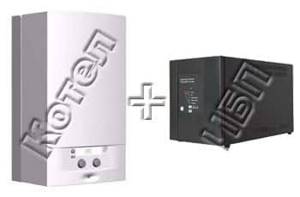
Uninterruptible power supply and boiler
